

After a leisurely breakfast (or after sleeping in a bit!), we boarded the buses to drive about an hour outside the city to Montserrat. This name refers to the mountain, to the sanctuary where we were to sing today (marked by the tower at the left), and to the associated Benedictine monastery, founded in about 1025.
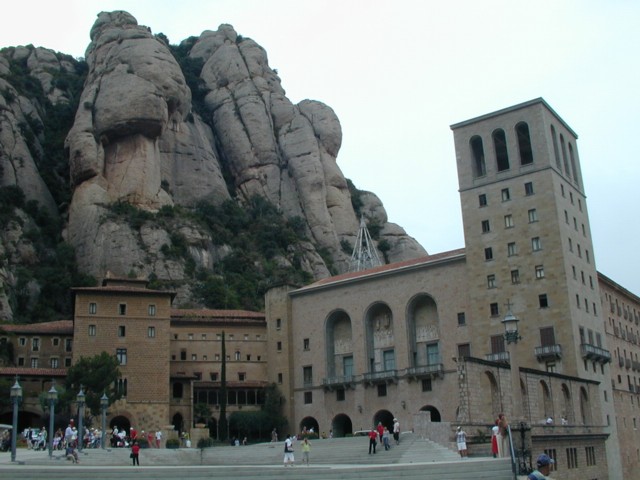
Montserrat is the spiritual and emotional heart of Catalonia. The site has been used as a hermitage at least as early as the ninth century; after the founding of the monastery, its popularity as a pilgrimage site grew for hundreds of years until a sudden and violent halt in 1811 when Napoleon, fearing his enemies would make use of the military potential of the location, ordered his troops to sack the monastery and sanctuary and burn the books in the library. The section to the lower left of center in this photo, with the small columns and irregularly-sized windows, is the only surviving part of the sanctuary from before the destruction. The monastery's surrounding lands were expropriated by the state in 1835, and it was deserted.
Within a quarter century, though, the monks had returned and begun to rebuild. The middle of the 19th century saw a rebirth, or Renaixença, of consciousness of the Catalan identity, and the restoration of Montserrat became a potent symbol. Today the site has grown to accommodate an ever-larger flow of pilgrims and visitors, especially Catalans who come for reasons of religious devotion or to celebrate life's milestones--weddings, anniversaries, graduations--in a place that uniquely belongs to them.
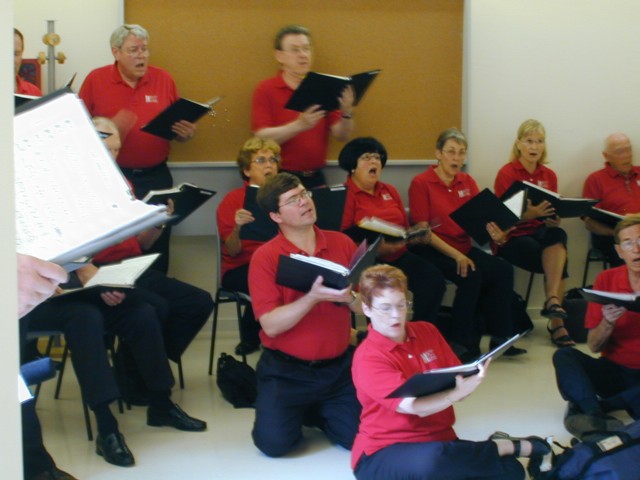
Montserrat also has facilities to host religious and scholarly conferences; we squeezed into a meeting room to warm up our voices. Montserrat hosts perhaps the oldest conservatory in Europe, the Escolania; this is a music school for boys that dates back to at least the 13th century. Every day, the boys' choir sings at midday for the pilgrims and visitors; they were on their summer vacation today, though, so we had the privilege of singing in their place!
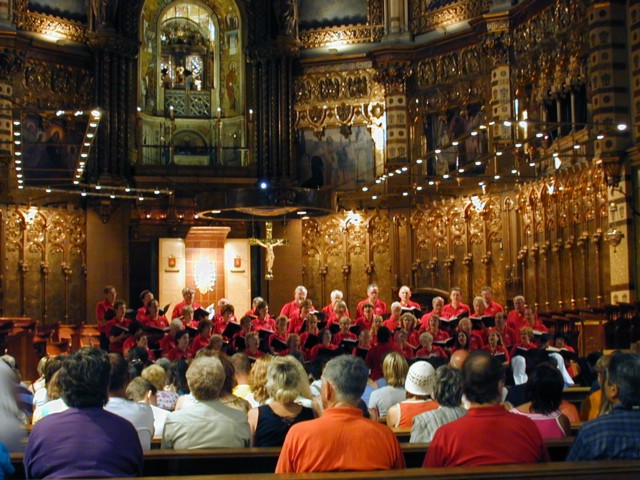
We sang four of our a capella pieces over about ten minutes; then we moved off to the side as one of the monks welcomed the crowd (around 500 according to Jim Belt's estimate) in at least half a dozen languages, reading a passage from 1 John and inviting us to join him in the Lord's Prayer in our own languages. Traditionally the choir of the Escolania sings the Gregorian chant "Salve Regina" (Hail Heavenly Queen) and El Virolai (about which a little more below), so we returned to the steps in front of the altar to sing these songs. The organist played along with us for these, which was helpful but a little confusing because we hadn't had a chance to work out exact tempos and rhythms beforehand the way we do with Lee! (This and the previous photo were again shot by Steve Campbell, who deserves congratulations for keeping a dead-steady hand as he shot in low light without a flash.)
If Montserrat is the heart of Catalonia, the image of Our Lady of Montserrat is the heart of Montserrat. This 12th-century sculpture is in the center of the arch above the brightly-lit altar in the photo above; you can see a couple of the steady stream of pilgrims who filed past while we were singing. The story goes that the image was found in one of the surrounding caves, perhaps left there by local people hiding from an invading army; as it was being carried down to the town below, it suddenly became very heavy, which the people took to indicate that the Virgin Mary wanted the image to stay where it was, at the monastery. The sculpture is in the "Black Madonna" style, with Caucasian features but made of a dark stone (perhaps influenced by the Moors who came from roughly the direction of the Holy Land, but nobody really knows), and an affectionate popular name for the image is La Moreneta, or the Little Dark One.
The reconstruction of Montserrat after its destruction by Napoleon went rapidly enough that in 1880 Catalans were able to celebrate its Millennary, a thousand years of its history. El Virolai was composed for this occasion by the poet Jacinto Verdaguer and set to a melody by Josep Rodoreda, so this year marks its 125th anniversary. (The term "virolai" refers to a particular musical and poetic form; I think the full title of the song is "Virolai a Nostra Senyora de Montserrat," or "A Virolai to Our Lady of Montserrat.") The song has eight verses and a chorus; usually the pilgrims sing along with the chorus, but leave the verses to the Escolania (just like most Americans know only one verse of the Star-Spangled Banner). We had been told that usually the boys' choir only sings a couple of the verses, and on a recording that they had made indeed they only sang the first and third verses, with the people joining in at the start and after each verse for the chorus. We had also been told that, in the boys' absence, the monks would be singing the verses; however, as the organ started playing, there wasn't a monk to be seen! Lori Sakai and Mike Costello had put in a lot of work finding the text (and a bootleg of that recording!) online, and sorting out the pronunciation; however, we had only really worked on the first verse. Fortunately for us, the organist stopped after we sang the chorus, the first verse, and the chorus again--otherwise we would have had just a couple of us singing any more verses, since we hadn't seen a need to distribute the text and pronunciation more widely in the choir! A near thing, but as it turned out we sang with a fair amount of confidence, and I think we served the pilgrims creditably.
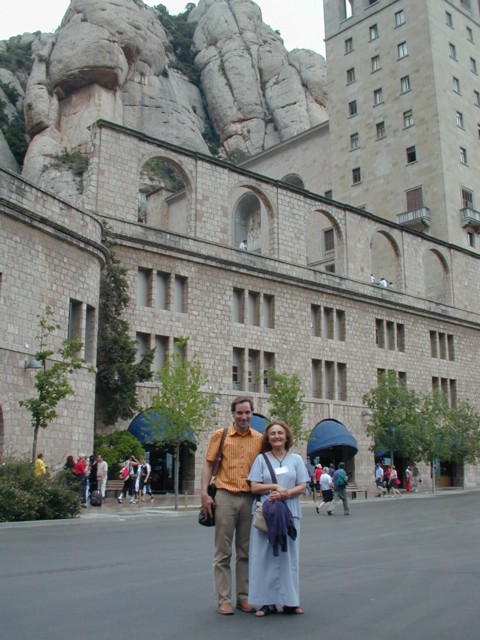
When we learned "Hen Wlad Fy Nhadau," the national anthem of Wales, for our 2002 tour, we had David Evans to help us figure out the pronunciation of the Welsh words. Catalan, though it has similarities to both Spanish and French, also has significant differences; and while Lori and Mike did an excellent job of figuring out the pronunciation of El Virolai, we were most grateful to have the help of two native speakers of Catalan to help us get this important song right! These are Oriol Brasó Campderrós and Mariá Valcárcel; Oriol is one of the two guides who will be with us the whole tour, and Mariá joined us to help him show us around Catalonia. Many thanks!
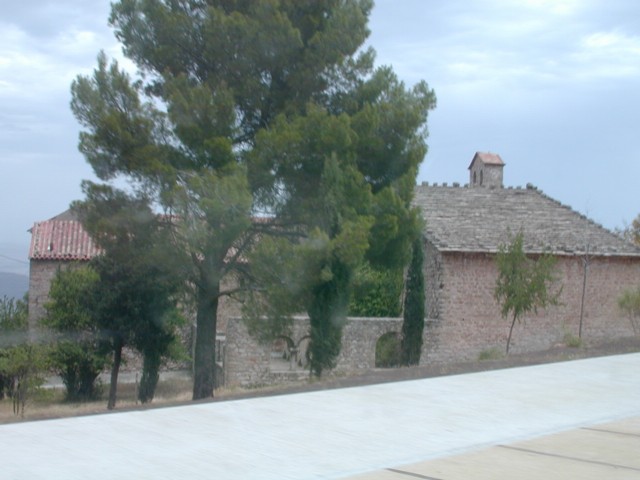
There are over a dozen hermitage sites around Montserrat, and numerous other monasteries for monks and nuns. On the way down the mountain we passed this 11th-century monastery dedicated to St. Cecilia, at whose chapel in the Catacombs of Rome some of us sang "Cantate Domino" on our 1999 tour.

Here is a look back over our shoulders at the entire mountain (as you can see from the blurry windows, it had rained a bit while we were there). The name "Montserrat" means "sawn mountain" ("mont" as in mountain, "serrat" as in serrated, i.e., sawtooth), because the upended and eroded sedimentary rocks look as if they had been shaped by a craftsman cutting pieces out of them. There are numerous churches and monasteries around the world dedicated to Our Lady of Montserrat; a former hermit on the mountain, Bernat Boïl, accompanied Columbus to America, and an entire island in the Caribbean as well as mountains and villages are named Montserrat. The mountain and monastery inspired poets, artists, and saints from Goethe to Loyola. We were honored to participate in the long-standing traditions of Montserrat!
 To
Wednesday, 29 June 2005
To
Wednesday, 29 June 2005 Back
to choir tour itinerary
Back
to choir tour itinerary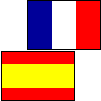 Back
to choir tour home page
Back
to choir tour home pagenew 28 June 2005